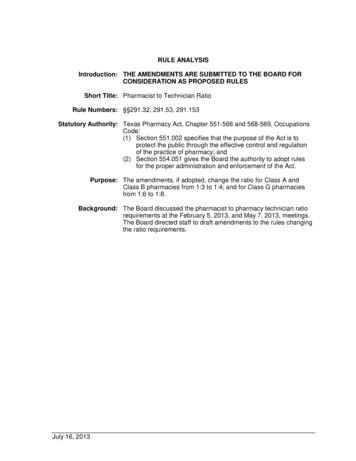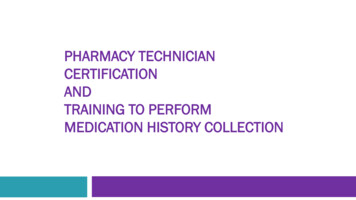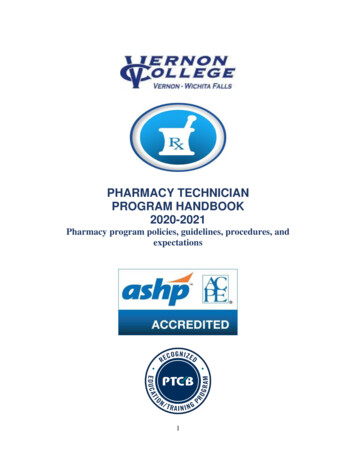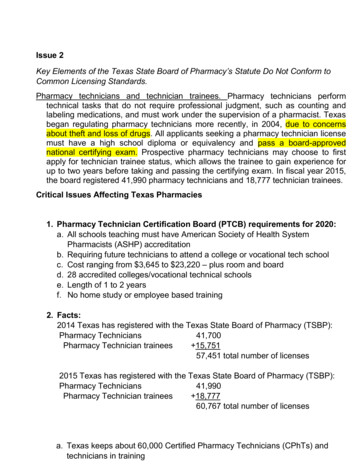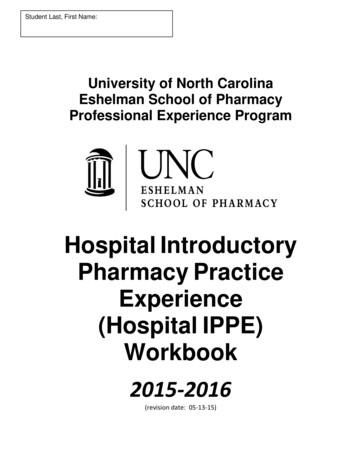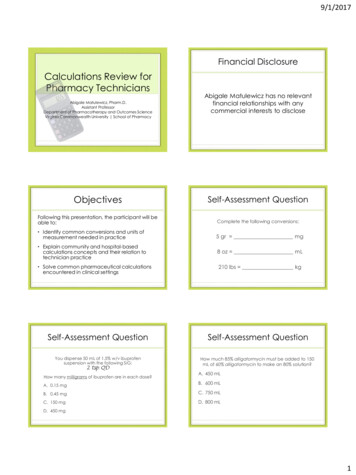
Transcription
9/1/2017Financial DisclosureCalculations Review forPharmacy TechniciansAbigale Matulewicz, Pharm.D.Assistant ProfessorDepartment of Pharmacotherapy and Outcomes ScienceVirginia Commonwealth University School of PharmacyAbigale Matulewicz has no relevantfinancial relationships with anycommercial interests to discloseObjectivesSelf-Assessment QuestionFollowing this presentation, the participant will beable to:Complete the following conversions: Identify common conversions and units ofmeasurement needed in practice5 gr mg Explain community and hospital-basedcalculations concepts and their relation totechnician practice8 oz mL Solve common pharmaceutical calculationsencountered in clinical settings210 lbs kgSelf-Assessment QuestionSelf-Assessment QuestionYou dispense 50 mL of 1.5% w/v ibuprofensuspension with the following SIG:How much 85% alligatormycin must be added to 150mL of 60% alligatormycin to make an 80% solution?2 tsp QDHow many milligrams of ibuprofen are in each dose?A. 450 mLA. 0.15 mgB. 600 mLB. 0.45 mgC. 750 mLC. 150 mgD. 800 mLD. 450 mg1
9/1/2017Topics to CoverSelf-Assessment QuestionAGENDA1. Units of measure and conversionsA 49-year old, 132-lb man is being started onoctreotide for variceal bleeding. He is getting 50mcg/hr and the drip contains 500 mcg of octreotidein 100 mL NS. What is the flow rate in mL/hr?2. Ratio, proportions and percent strength3. Stock solutions and alligationA. 1 mL/hr4. Clinical-based calculationsB. 10 mL/hr5. Parenteral calculationsC. 50 mL/hrD. 100 mL/hrRoman NumeralsUNITS CONVERSIONS Reading Roman numerals:Lower number after high number add XIILower number before higher subtract IXSmaller number between two larger XIXAvoid repetition of 3 occurrences of theNumbersame letter IIIIIII VII1 Power of 10 IC XCIX5 Use only one smaller number before a10larger number IIX VIII50Practice Problem #1UNITS CONVERSIONSWhat number Super Bowl is representedin the image below? RomanNumeralI or iV or vX or xL100C500D1000MI mage Source: owl-unused-logos/Systems of MeasurementMetric--International System of Units-Standard for USP-Use prefixes to indicatenumeric valueCommonly seen units:AvoirdupoisUNITS CONVERSIONSApothecaryHousehold MeasurementsCommonly seen units:Millimeter, centimeterOunceGrain, dram, scrupleMilliliter, literPoundFluid ounceMilligram, gram, kilogramGrainPint, quart, gallonHousehold UnitEquivalentVOLUME-British-based system-Used in healthcare-Household measurements-Primarily used formass measurements in United States (volume)Commonly seen units:UNITS CONVERSIONS1 teaspoonful (tsp)5 milliliters (mL)1 tablespoonful (tbsp)15 mL1 fluid ounce (fl oz)30 mL1 cup8 fl oz1 pint (pt)16 fl oz4 quarts (qt)1 gal1 gallon (gal)3.785 L1 pound (lb)16 ozWEIGHT2
9/1/2017Other ConversionsUNITS CONVERSIONSMeasurementEquivalent1 pound (lb)454 g1 kilogram (kg)2.2 lbs1 grain (gr)65 mg*1 dram5 mLPractice Problem #2UNITS CONVERSIONSComplete the followingconversions:1. 5 gr mg2. 8 oz mL3. 210 lbs kgTips on RememberingUNITS CONVERSIONSChallenge! UNITS CONVERSIONS Drug written? Quantity todispense in mL? Amount patientshould take perdose?Image Source: http://www.pinterest.comKey PointsUNITS CONVERSIONSImage Source: Finkel R. Patient Care Management Lab – 2nd EditionTopics to Cover Pharmacy practice uses principles from allthree systems of measurement1. Units of measure and conversions Knowing householdequivalents and otherconversions is crucialfor pharmacy practice3. Stock solutions and alligationAGENDA2. Ratio, proportions and percentstrength4. Clinical-based calculations5. Parenteral calculations3
9/1/2017Basic RefresherRATIOS PROPORTIONS Ratio is comparison of two like quantities Fraction (2/3) or ratio strength (2:3) Very common in drug strength notation Proportion is when two ratios are equal Generally set up as :AC BD 3 Rules to Follow:1. Numerators should have same units2. Denominators should have same units3. Three of the four “spots” should be knownConcentrationsRATIOS PROPORTIONS Weight / weight (w/w) Represented as MILLILITERS PER 100 MILLILITERS Not used very often in practice; chemicals? Weight / volume (w/v ) Represented as GRAMS PER 100 MILLILITERS Example: 5% 5 grams / 100 mL Most common way to express concentration in practiceRATIOS PROPORTIONS If given in percent strength 4g 1100 mLX180 XgRatio StrengthRATIOS PROPORTIONS Example: 0.2% (w/v) 1:500 (w/v) Same rules as percent strengthfor units Used frequently in hospital practicePractice Problem #4RATIOS PROPORTIONSX 25 (1:25)You dispense 50 mL of 1.5% w/v ibuprofensuspension with the following SIG:X 1.25How many milligrams of ibuprofen are ineach dose?. If given as ratio strength 1:80 (w/w) (1.25%)A prescription is written for a300mg dose of an oral solution.The pharmacy stocks a 250mg/5mL stock bottle. How much ofthe stock solution should betaken per dose? Often used to show the concentration of“weak” preparations Volume / volume (v/w)4% (w/v) RATIOS PROPORTIONS Written as X:Y, where X is usually 1 Represented as GRAMS PER 100 GRAMS Used for solids, semisolidsConverting BetweenPractice Problem #32 tsp QD100g4
9/1/2017Challenge! RATIOS PROPORTIONSA formula for tinea capitis shampoocontains 1:62.5 (w/v) selenium sulfide.How many capsules, each containing350 mg of selenium sulfide, would beneeded to prepare 1 pint of shampoo?Key PointsRATIOS PROPORTIONS Remember to always match your units whensetting up proportions Percent strength is represented as “per 100” Whether using ratio or percent strength, youcan always solve for quantity needed bysetting up proportionsRingwormTopics to CoverAGENDA1. Units of measure and conversions2. Ratio, proportions and percent strength3. Stock solutions and alligationSTOCK SOL’N ALLIGATION Concentrated solutions used to prepareweaker ones Diluting gives smaller concentration in highervolume for easier dosing General Rules:4. Clinical-based calculations Working with percent strength is typically easiest May require multiple steps to be the mostaccurate5. Parenteral calculationsLiquids vs. SolidsStock SolutionsSTOCK SOL’N ALLIGATIONUsing ProportionsSTOCK SOL’N ALLIGATION Liquid Dilutions: Changes the concentration ( or ) Usually know 3 of 4 necessary components Proportion-based calculation is easiestvolume of stockdesired % strength volume needed% strength of stockOR Solid Dilutions: Adding base to creams and ointments Usually lowering the concentration% strength of stockdesired % strength volume of stockvolume needed5
9/1/2017Practice Problem #5STOCK SOL’N ALLIGATIONHow many milliliters of 1:500w/v solution is needed tomake 3 L of a 1:2000 w/vsolution?Using AlgebraSTOCK SOL’N ALLIGATIONC1 x V1 C2 x V2 C strength (concentration)V volume (quantity) Usually set up as HAVE WANT Any units work as long as they match oneither “side” KEY CONCEPT: base has a strength of 0%Practice Problem #6STOCK SOL’N ALLIGATIONIf 200 mL of an 8% w/vpotassium chloride solution isdiluted to 1500 mL, what isthe new percent strength ofthe diluted solution?AlligationSTOCK SOL’N ALLIGATION Two different types: Medial for determining new % strength whencombining multiple strengths of same ingredient Completely math based Alternate for determining volume needed toget new % strength Visual/grid basedAlligation MedialSTOCK SOL’N ALLIGATION Two ways to tackle1. Use total volume of solutions, total grams ofingredients in solution and set up proportion2. Convert percent strength into decimals andmultiply by their volumes, then calculate newstrength Alligation MedialSTOCK SOL’N ALLIGATIONWhat is the new percent strength when 100 mLof 50% dextrose is mixed with 250 mL of 40%dextrose and 450 mL of 70% dextrose?1. Proportion:2. Decimals:Both methods produce same answer 6
9/1/2017Alligation AlternateSTOCK SOL’N ALLIGATIONPractice Problem #7 Think of it as math “tic-tac-toe”How much 85%alligatormycin must beadded to 150 mL of 60%alligatormycin to makean 80% solution?Image Source: ligation.htmlKey PointsSTOCK SOL’N ALLIGATIONImage Source: http://images.google.comSTOCK SOL’N ALLIGATIONBRAIN BREAK!STAND UP AND STRETCH When working with stock solutions, usingpercent strength is generally easiest When using alligation alternate, correct setup is key to success! Units and conversionfactors apply toalmost everyscenario Alligationisn’t soscaryanymore!Image Source: http://images.google.comTopics to CoverAGENDA1. Units of measure and conversions2. Ratio, proportions and percent strength3. Stock solutions and alligation4. Clinical-based calculations5. Parenteral calculationsClinical CalculationsCLINICAL BASED CALCS Factors to consider: AgeWeightBody surface area (BSA)Key organ function (liver, kidneys, etc) Common scenarios/drugs encountered: Antibiotics Chemotherapy7
9/1/2017PediatricsCLINICAL BASED CALCS Anyone under age of 18CLINICAL BASED CALCS Clark’s RuleCategoryAge RangeNeonateBirth – 1 monthInfant1 month – 2 yearsChild2 years – 12 yearsAdolescent13 – 17 years Weight of patient and adult doseweight (lbs) adult dose child dose150 Young’s Rule 3 Common Mechanisms for Dosing: Age of patient and adult dose Clark’s Rule Young’s Rule Weight-based dosingPractice Problem #8Clark’s and Young’s Ruleageage 12CLINICAL BASED CALCSA 6-year-old child weighs 42 lbs.The adult dose of an antibiotic is375 mg. What is the child’s dose? adult dose child doseWeight-Based DosingCLINICAL BASED CALCS Given as dose per body weight of patient Examples: milligrams per kilogramgrams per pound Most accurate way to dose for any patient May be mg/kg/day OR mg/kg/doseCalculate using both Clark’s and Young’s RulePractice Problem #9CLINICAL BASED CALCSA dose of enoxaparin sodium is1 mg/kg Q 12h SC. If a prefilledsyringe containing 80mg/0.8 mLis used, how many millilitersshould be administered perdose to a 154-lb patient? Pay attention to units and use conversions Day SupplyCLINICAL BASED CALCS How long a prescription will last the patientmaximum amount used in 1 daytotal amount dispensed What do you do in practice when the daysupply ends up NOT being a whole number? Round up? Round down?8
9/1/2017Day SupplyCLINICAL BASED CALCSPractice Problem #10CLINICAL BASED CALCSA patient has the following directionsfor their insulin:15 units AC, 10 units QHS What about prescriptionsfor topicals? Fingertip unit (FTU) What about ear andeye drops?You are dispensing two (2) 10-mL vialsof insulin. How long will the vials lastthe patient? 1 mL ? dropsImage Source: http://images.google.comKey PointsCLINICAL BASED CALCS PEDIATRICS DOSINGTopics to CoverAGENDA1. Units of measure and conversions Clark’s and Young’s Rules can be used toestimate doses but may be inaccurate2. Ratio, proportions and percent strength3. Stock solutions and alligation4. Clinical-based calculations WEIGHT-BASED DOSING Double check units of dosing before calculating Always the most accurate dosing mechanismCommon CalculationsPARENTERALS5. Parenteral calculationsFlow RatePARENTERALS Intravenous fluids must have rate of admin Flow rates Given in milliliters per time (hour/min)Volume (mL)Time (hr) Rate Drop sets Given in drops per time (hour/min)Use same equation above but multiply calibration (drops/mL) Volume 250mL IV piggyback; run for set time Volume 500mL large volume; runcontinuously Your role determining howmany IV bags to make tolast the patient Usually for 24-hour periodin hospitalImage Source: http://images.google.com9
9/1/2017Practice Problem #11PARENTERALSA 49-year old, 132-lb man is beingstarted on octreotide for varicealbleeding. He is getting 50 mcg/hrand the drip contains 500 mcg ofoctreotide in 100 mL NS. What isthe flow rate in mL/hr?Drop SetPARENTERALS Iv solutions given via tubing set Each set has specific number of drops in 1 mLCommon Tubing Set Drop Rates10 gtt/mL15 gtt/mL20 gtt/mL60 gtt/mL (microdrip)gtts/min (volume/hr) x drop rate60 min / hourKey PointsPARENTERALS Institutional pharmacy uses military time formedication administration and duration 0000 midnight1200 noon1800 6PM Flow rates are generally givenin mL per hrChallenge! PARENTERALSA 1liter IV runs from 0700 to1500.A. What is the flow rate in mL/hr?B. How much of the solution is remainingafter 5 hours?C. What is the drop rate (in mins) for a 15gtt/mL tubing set?Practice Problem #12PARENTERALSAn IV is beingadministered at 75 mL/hr.What is the drip rate inminutes for a 20 gtt/mLtubing set?Self-AssessmentQuestionComplete the following conversions:5 gr mg8 oz mL Drip rates are generally givenin gtt per min210 lbs kgImage Source: http://images.google.com10
9/1/2017Self-Assessment QuestionSelf-Assessment QuestionYou dispense 50 mL of 1.5% w/v ibuprofensuspension with the following SIG:How much 85% alligatormycin must be addedto 150 mL of 60% alligatormycin to make an 80%solution?2 tsp QDHow many milligrams of ibuprofen are in each dose?A. 0.15 mgA. 450 mLB. 600 mLB. 0.45 mgC. 750 mLC. 150 mgD. 800 mLD. 450 mgSelf-Assessment QuestionQuestions?A 49-year old, 132-lb man is being started onoctreotide for variceal bleeding. He is getting 50mcg/hr and the drip contains 500 mcg of octreotidein 100 mL NS. What is the flow rate in mL/hr?A. 1 mL/hrB. 10 mL/hrC. 50 mL/hrD. 100 mL/hrReferences Agarwal P. Pharmaceutical Calculations. Burlington, MA: Jones andBartlett Learning; 2016. Ansel HC. Pharmaceutical Calculations. 14 th Edition. Baltimore, MA:Lippincott Williams & Wilkins; 2012. Augmann RN, Lockwood JS. Mathematics with Allied HealthApplications. Belmont, CA: Brooks Cole CENGAGE Learning; 2013. Finkel R. Patient Care Management Lab – A Workbook forPrescription Practice. 2nd Edition. Baltimore, MA: Lippincott Williams &Wilkins; 2008. Neville JL. Pharmacy Technician Exam Review Guide. Burlington, MA:Jones and Bartlett Learning; 2013. Zentz LC. Math for Pharmacy Technicians. Sudbury, MA: Jones andBartlett Learning; 2010.11
Pharmacy practice uses principles from all three systems of measurement Knowing household equivalents and other conversions is crucial for pharmacy practice UNITS CONVERSIONS Topics to Cover 1. Units of measure and conversions 2. Ratio, proportions and percent strength 3. Stock s
